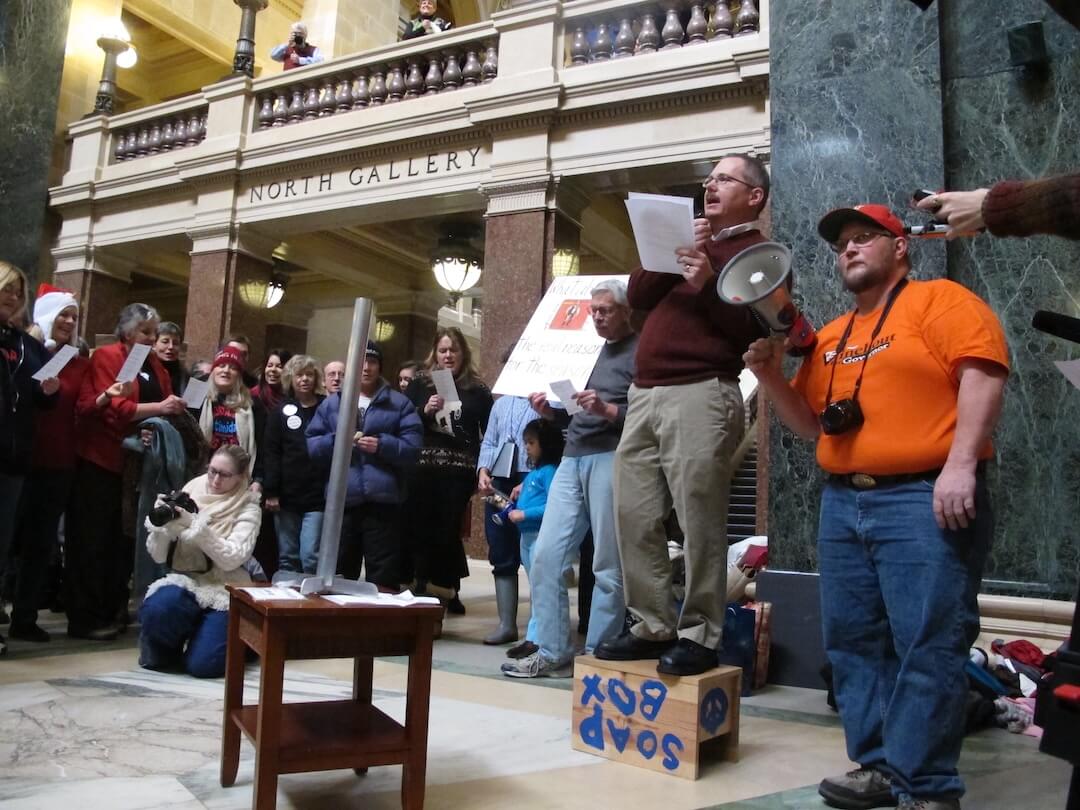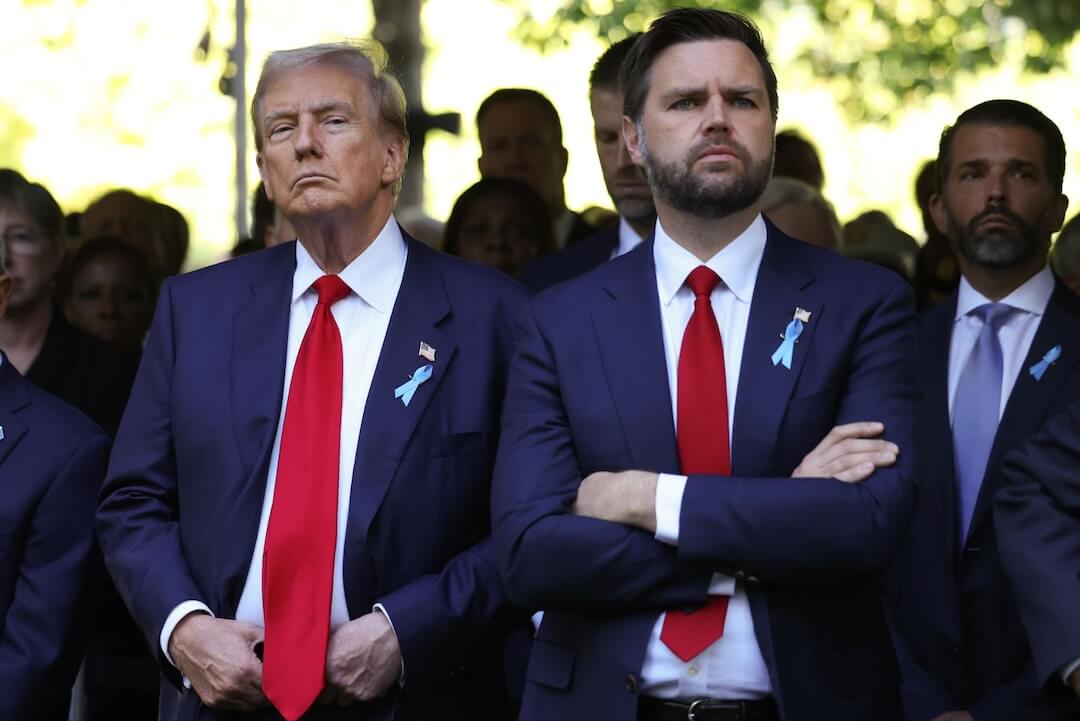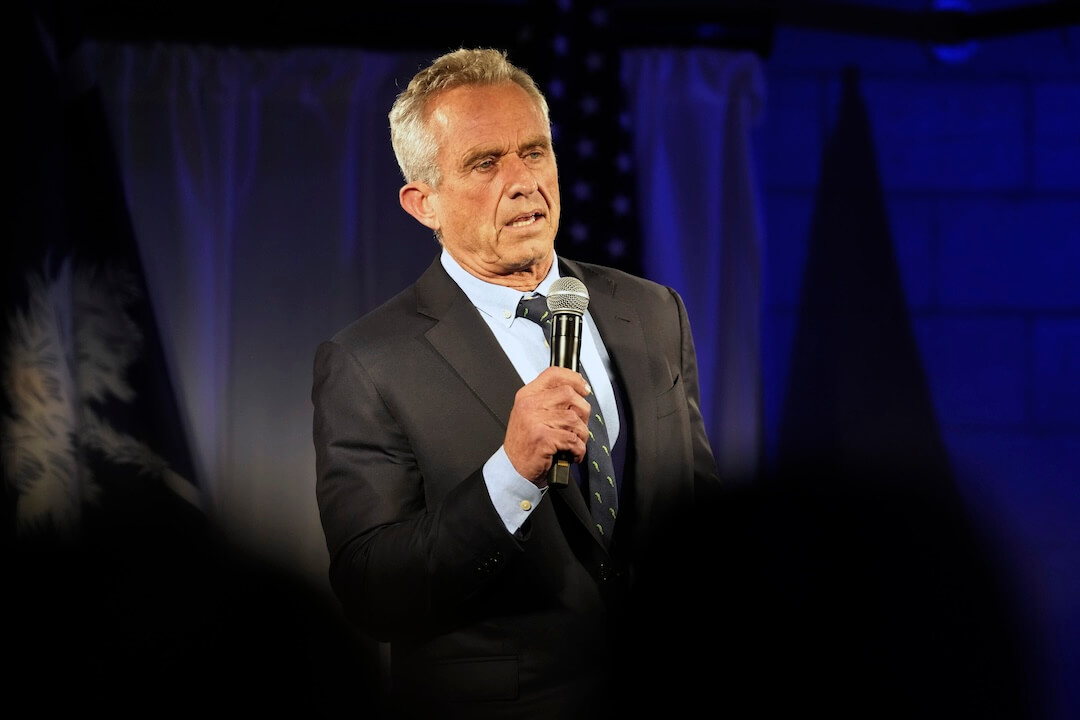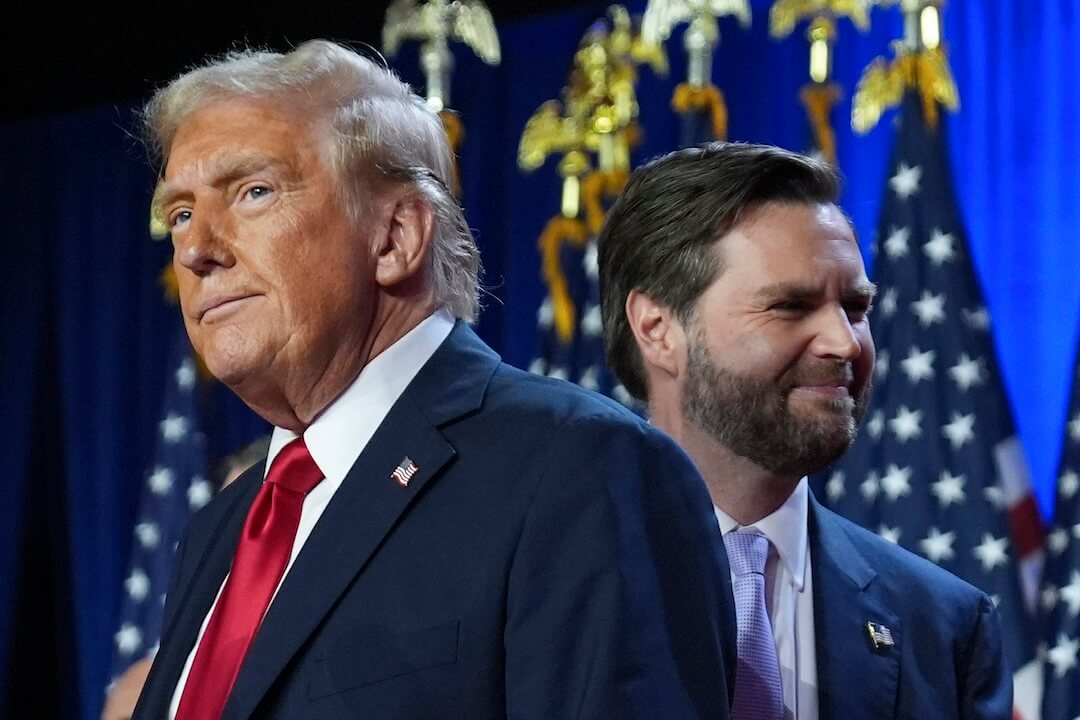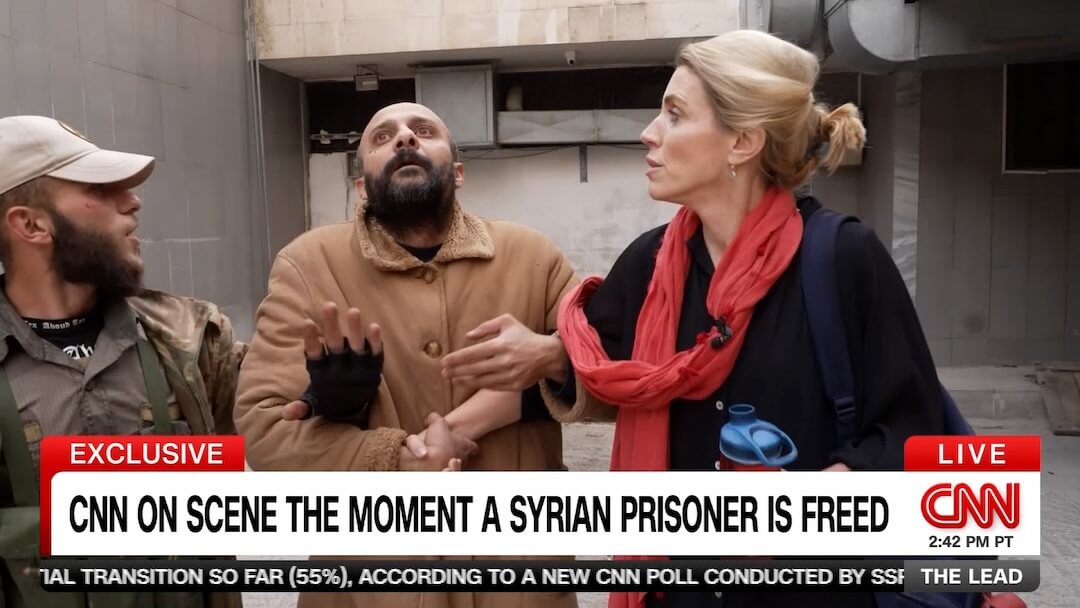Kelly Moffitt lives in St. Louis, where she works as an online producer at St. Louis Public Radio. Until recently, however, the podcasts she listened to were very much a bicoastal affair.
“One day, I looked down at my phone and realized all of my regular-listening podcasts were from New York or Los Angeles,” she said. “I was stunned.”
Podcasts taped in New York City, Washington, D.C., and Los Angeles — cities home to the biggest podcasting networks and distributors — consistently dominate the top slots on iTunes, which remains one of the biggest discovery mechanisms for new podcasts.
Moffitt wants to help people discover podcasts that don’t originate on a coast. Her new newsletter, Flyover Podcast, shares podcasts produced “between the coasts,” interviews with podcasters around the country and listening recommendations for episodes from Nashville, St. Louis and elsewhere.
“I know that consistently hearing voices from a particular coastal perspective, especially given how intimate podcasting is, further alienates me from the voices of my own home,” Moffitt said.
And her home — St. Louis — happens to harbor a huge podcasting community. There are more than 130 people in the podcasting meetup in St. Louis, a ton of local podcasts, and there’s a pretty robust discussion that takes place each week using the #stlpodcast hashtag. I reached out to Moffitt to talk about podcast discovery outside of New York, L.A., and Washington, D.C. — and how public radio stations around the country could help support this ecosystem.
What’s in the water in St. Louis? Why are so many people into podcasting?
Moffitt: Well, the city does sit at the confluence of two of the nation’s mightiest rivers, so maybe that has something to do with it? In all truth, I don’t think St. Louis is that out of the ordinary in this. There are many cities and regions between the coasts that are producing a large number of quality podcasts. Our region is populated by 2.8 million people. With that many people living in a media-saturated environment and plugged into latest trends, it only makes sense that some would gravitate toward the podcasting platform.
St. Louis is a town that is fiercely loyal to its sports teams, and there was a strong early group of podcasters here (I’m talking mid-2000s), who used the platform explicitly for sports talk. And many local radio stations have long been distributing their own talk shows in the form of a podcast (like the one I produce, St. Louis on the Air).
The early adopter community laid a strong foundation for the second iteration of podcasting we’re seeing today, which includes more narrative, comedic, fandom, fictional and reported podcasts. Podcasting here has solidified and grown with a training-oriented podcasting meetup group, free recording and editing equipment available at St. Louis Public Library, a handful of vibrant podcast listening groups and several locally owned podcast production collectives, like STL Vernacular and 2 Guys Talking.
With this most recent boom, many large, legacy media organizations like St. Louis Public Radio, KMOX, KDHX and the St. Louis Post-Dispatch have jumped into the fray, producing podcasts independent from other daily products.
That gets the term “podcasting” in front of generous audience numbers every day and helps acquaint people with the platform. For example, at St. Louis Public Radio alone, we have three weekly or bi-weekly podcasts produced separate from terrestrial radio programming: We Live Here, Politically Speaking and Cut & Paste. The organization has also produced two limited-run, standalone podcasts, St. Louis History in Black and White (remixed from talk show content) and the Millennium Mayor, which was attached to a planned news event.
How does St. Louis Public Radio view and collaborate with this ecosystem?
Moffitt: Up to this point, there hasn’t been much collaboration. Aside from the event I organized last year and some talk shows I’ve produced about local podcasts, there hasn’t been a lot of outreach or formal systems set up for that collaboration.
I believe there are plans in the works for a programming position that would have more of a hand in this type of cultivation, but it hasn’t been fully fleshed out by St. Louis Public Radio. Possibly because it has taken a while for podcasting within the organization to carve a strong foothold and box out a niche that would be hard to compete with.
I see this as an issue in the public radio system overall. Last week, I profiled a podcast that is a collaboration between WFPL (Louisville’s NPR affiliate) and two community members who have no background in radio but plenty of expertise on Black gay life in their community: Strange Fruit podcast. Laura Ellis, a producer for the station, lends narrative and audio expertise to the community co-hosts, Dr. Kaila Story and Jaison Gardner, who research and host the podcast. Those kinds of partnerships are few and far between in local public radio and, although it comes with challenges, it shows what is possible.
In public radio’s role as a community partner, we should be looking to serve the needs of our local community and reflect the voices not formally associated with the station. We’re always talking about wanting to provide these services, and the ascendancy of podcasting provides several actionable ways to do that. Some ideas I’ve thought about:
1) Utilize staff audio and storytelling expertise to help train local podcasters and up the quality of locally produced podcasts. Perhaps create a standardized podcasting course.
2) Provide unused studio space to local podcasters and pay a trained engineer to help record and mix.
3) Catalog a list of locally produced podcasts and host a spot on your website for that list. Or, more extreme, create local programming blocks that play full hours of locally produced content from outside the station.
4) Create a local podcast producer position to reach out to people in the community that could fill gaps in the station’s coverage and coordinate, fact-check and polish local podcast productions.
These ideas could be revenue-generating or a community service, but they all either provide skills community members want or raise up local voices that are more diverse in every way than most public radio stations are.
How do you think about local podcasts: does a podcast have to be about a place for it to be considered local?
Moffitt: Certainly not! When I launched the newsletter, one of the first, we’ll say, lukewarm, responses I received was that subject matter rather than site of origination determined whether the listener would listen. I’m here to tell you that after six months of research on this project: podcasts produced between the coasts cover nearly every subject under the sun. That means there are local podcasts about the places themselves, like the podcast I’m profiling this week (interviews with everyday “legends” of Springfield, Illinois) and podcasts about subject matter (like this Wisconsin-based podcast about slogging through “Infinite Jest”).
What I really want people to be aware of is where the voices they listen to on podcasts are coming from. One day, when I looked down at my phone and realized all of my regular-listening podcasts were from New York or Los Angeles, I was stunned. I have a MA in Journalism! I’m pretty damn media critical about what I consume. I know that consistently hearing voices from a particular coastal perspective, especially given how intimate podcasting is, further alienates me from the voices of my own home.
I recently spoke with Berry Syk, the Denver-based creator of a podcast catalog called Podcasts in Color, who drove this idea home for me. She spoke about how coastal podcasts often advertise with the tagline “iTunes or wherever you get your podcasts.” She pointed out that phrasing is pretty alienating to Android users who listen to podcasts … also known as the majority of the country. How many more listeners could we catch if we used more instructive language?
I would challenge people to think of the voices they are missing when they don’t at least register what place their podcast comes from. Place informs us, changes our perspective of what is normal. In the most recent newsletter, Dr. Story said, in reference to the whitewashing of LGBTQ identity in mainstream media, that kind of story “wasn’t true for us, or the people we know” in Louisville. That’s what inspired her and her co-host to create Strange Fruit, which focuses and illuminates Black gay life. Expanding our understanding of what is true for different people, and for the people in their vicinity, is a worthwhile effort.
You hosted an event at the public radio station for people in St. Louis who wanted to enter podcasting. How did it go, and what advice would you give to other stations who want to follow suit?
Moffitt: The event went better than I possibly could have imagined. Over 120 people showed up for an hour-long taping with five local podcasters discussing how to get started in podcasting, which was later broadcast on St. Louis on the Air. We opened up the floor for questions and I organized tables in the lobby with other local resources. After the event, people stuck around for a long time talking with each other, asking questions, and expounding on their own plans for podcasts to come.
One of the challenges I meet in my daily work is how to incorporate community engagement practices into a daily public affairs/cultural talk show. We move on from subjects so fast! But public radio programming started with the intent to provide educational content to our community and to connect our community with each other. I could make a case for a broadcast that teaches people how to make their own media and introduces a community to each other. I think public radio stations don’t have to create such an event tied to a talk show, but it does help the instructional material reach a much larger audience.
If you’re planning to do your own event, there are three pieces of advice I’d follow:
1) Start the process of looking for podcasters of quality early. I started planning this event about four months out, which gave plenty of time for on-air promotion, cross-promotion on the podcasts and in community spaces.
2) Think about how you will have the how-to portion of the program live on. I created this guide.
3) Reach out to individual podcasters, even if they aren’t on the panel, to be “expert voices” in the room. Reach out to local recording studios, libraries and other media organizations as well. Invite them to table and answer questions from listeners.
Your weekly newsletter Flyover Podcast introduces people to podcasts made between the coasts. How did you get the idea for the newsletter?
Moffitt: The reason is three-fold. One, because I work in a place associated with NPR, I often get asked about what podcasts to listen to on the next road trip. Two, I realized one day that all the recommendations I would give out I found from the top of the iTunes podcast chart or national media organization. Three, I knew there was a plethora of podcasts produced in places besides New York and Los Angeles because of the amount of locally produced podcasts in St. Louis. Putting those three things together made me a bit angry.
Why don’t more people know about the podcasts produced outside of major hubs? I decided that if a method of podcast discovery that privileged podcasts produced between the coasts didn’t exist yet, I’d make it happen with a weekly newsletter. Aside from the episode listening recommendations, I also share an interview with the producer behind the podcast, hoping to share skills and thinking that could prompt other people to create their own podcasts or better what they’re already doing.
How do you find content for the newsletter?
Moffitt: I merge the digital and analog. On the wall of my bedroom, I keep a map and everywhere I’ve profiled a podcast, I stick a dot on that location. That helps me visualize the concentration of coverage I pursue. When I notice a gap, I start specific googling for local podcast collectives, radio stations and social media groups/conversations about podcasting. I have a giant list of the all the podcasts I’m finding, organized by state, then region, and then denoted by independent/affiliated.
I also chart the different background/diversity of experience each podcaster I profile brings to the table. I search explicitly for voices and experiences I’m missing. I ask each podcaster I interview about “flyover podcasts” they listen to and I’ve also had a lot of great back-and-forth with subscribers to the newsletter recommending either their own podcasts or podcasts they listen to from flyover country.
What has surprised you about writing it?
Moffitt: In interviewing people who produce local podcasts, very few people actually listen to other flyover podcasts besides their own. It takes so much work to find them! Most times, the conversation trails off with the interviewee saying something akin to “well, I guess that’s why this newsletter exists.” At the same time, these podcasters often have a great depth of experience and some pretty groundbreaking things to say. We can learn a lot from local podcast producers.
Where do you find the podcasts you listen to?
Moffitt: Before I started this newsletter, I mostly found my podcasts from the top of the iTunes chart, advertisements on terrestrial NPR, guest/contributor episodes on shows like “This American Life” and random viral podcast posts on social media. It wasn’t streamlined or intentional at all.
This project, in some ways, is a test to find a better way of finding podcasts for myself by self-starting my podcast discovery podcast. So far, I’ve had a lot of “Oh my gosh, I can empathize with this” moments when I really didn’t expect it.
You’re a super prolific writer and you wear many, many hats — from event production to writing to production. I’m wondering how you balance all of your many skillsets, and how you manage your time.
Moffitt: I produce a local talk show, which means I produce 2-4 segments of live radio per week, in addition to the work of my colleagues. I also manage the digital presence of the program and am constantly experimenting with new ways to engage the community in conversation, events and customer service.
A lot of people separate out content production from digital production and in-person community engagement, which I think is a mistake. Having all of these skillsets in my toolbox is a less stressful way to structure my work day because I’ve learned what tool to pull when to serve the audience.
The activities that fit into my day are determined and privileged based on what I think/what I am hearing from the community about what would be of use to them. On a daily basis, that is often translating our talk show into digital content that saves the reader time but still ignites learning/imagination/discovery. On other days, it may be taking people where they can’t go themselves with Facebook Live. Or organizing an event that allows the attendee to ask their own questions. I grew up as someone who juggled a lot of different lifestyles, so this kind of melding and multitasking feels natural to me.
What I feel like I’m missing from my day job at St. Louis Public Radio, I find ways to fill in with other skills I want to garner, like starting this newsletter to connect with a broader community or co-founding/organizing the local chapter of Online News Association to help keep local journalism strong in a digital era.
Do you have advice for people in St. Louis who want to enter the podcasting ecosystem?
Moffitt: Listen to a ton of podcasts, take notes, and break down how other podcasters structure their time. When do you stop paying attention? How did the host phrase a particularly insightful question? Make notes and try out similar formulas for yourself. Invest in a quality microphone and recorder or, if it is a talk-style podcast, invest in some studio recording time. If you are recording in the field, remember to record at least 30 seconds of room tone to layer under transitions and cuts that otherwise sound abrupt. I’d also spend some significant time on social media, looking for other people/groups that you could reach out to for advice about getting started.
Lastly what St. Louis centric podcasts would you recommend for people? Why?
Moffitt: Aside from the podcast version of St. Louis on the Air, which will give you a little bit of everything, here are some of my favorites:
We Live Here — Produced by my colleagues Kameel Stanley and Tim Lloyd, this is the podcast for “people somewhere on the woke spectrum,” which charts issues of race, class, power and poverty. It’s a must-listen for St. Louisans wondering how the region came to be this way and, really, for anyone who wants to delve further into systemic race issues.
Hold That Thought — I love delving into the strange tangents/research of academia and this podcast, produced by Washington University in St. Louis, does that in an artfully wrought manner, combining interviews with researchers and compelling narration about its broader context.
Treehouse Lifestyle — Treehouse Networkshop founder Wesley Hoffmann interviews with St. Louis makers and entrepreneurs about career, lifestyle, relationships, motivation and innovation.
Sorry, Please Continue — I love this storytelling show! Described as a cross between “The Moth” and “Mystery Science Theater 3000,” the hosts Kenny and Jeremy record themed stories live from members of the community in St. Louis and Cleveland with interruptions from a cast of comedians, offering commentary.
Earthworms — My dad is a horticulturist by trade, but I never developed a green thumb, so I appreciate this podcast from KDHX, the independent, non-commercial radio station in town, about environmental issues and all things green.
Nerd for a Living — I’m always impressed and surprised by the caliber of guests Nerd for a Living books for their podcast about helping “people of the nerdish persuasion” discover sustainable career paths in the industries they love, like comic books, gaming, filmmaking, television and publishing.


